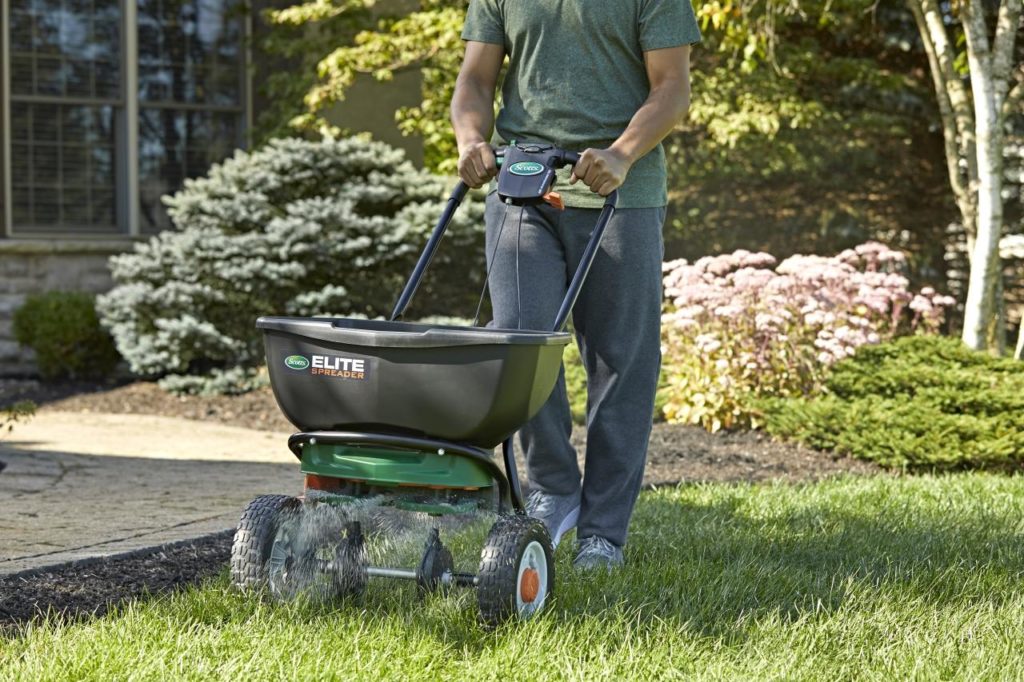Scotts – Top 10 Questions People Ask Most About Lawn Fertilizing

If you’ve struggled in the past to maintain a lush, green lawn and you find yourself eyeballing your neighbor’s with envy, it’s time to turn those tables. What we’re talking about here is lawn fertilizing — how to do it, when to do it, how often to do it, and so much more. Ready to get cracking? After all, that lawn isn’t going to feed itself!
1. What is lawn fertilizer?
Think of lawn fertilizer this way: No matter how many glasses of seltzer you drink, you can’t live on it—you need to tuck into a few good meals each day, too. Your lawn is just the same. As much as it needs water, it also needs additional nutrients to survive, and lawn fertilizer supplies those nutrients.
The best rule of thumb is to fertilize four times a year, in early spring, late spring, summer, and fall.
2. What do the letters NPK on the fertilizer bag mean?
Those letters stand for the nutrients nitrogen (N), phosphorus (P), and potassium (K). The numbers you see on the bag (32-0-4, for example) let you know the percentage of the N, P, and K (by weight) that’s in the bag. Here’s why it matters: Nitrogen greens up your grass and helps it grow, phosphorus stimulates root growth and helps seeds sprout, and potassium helps your lawn withstand drought and disease. The highest number for lawn fertilizers will usually be the “N”—after all, growing green grass is the ultimate goal, right?
3. How do I know which spreader setting to use?
There are several easy ways to help you figure out the right spreader setting. Try one of these:
● Visit the product information page for your particular fertilizer on Scotts.com and look for the guidelines in the “Spreader Settings” under the “Learn” tab;
● Use our Spreader Settings tool on scotts.com;
● Or, read the spreader settings guidelines on the product package.

4. Is there a best time of day to apply fertilizer?
Late afternoon or early evening (when there’s still light, of course) is the best time of day to apply lawn fertilizer. Applying it in the heat of a scorching afternoon can cause the sun’s rays to burn your grass—and when your goal is “lush and green,” burned grass blades simply won’t cut it.
5. How long after fertilizing should I wait to water my lawn?
It depends on the fertilizer. Some lawn foods perform better when you water them in right after applying, while others—such as some weed-and-feed products—need to be watered a day or two after fertilizing. It all comes down to this: Check the product directions on the bag—they’ll tell you when to water.
6. How long do I need to keep kids and pets off the lawn after fertilizing?
A good rule of thumb here is to allow 24 hours after rainfall or irrigation has watered in the fertilizer before letting kids or pets play on the lawn. So, for example, if you fertilize on Thursday and water or have rain on Friday, then on Saturday, you can let everyone release all of their pent-up energy out in the yard.

7. When is it too hot or too cold to apply fertilizer to my lawn?
This depends upon whether you have cool-season grass or warm-season grass. The best time to fertilize your lawn is when the grass is actively growing, and for cool-season grasses, that’s when temperatures are 60 to 70 degrees F. For warm-season grasses, active growth will usually happen when temperatures are between 75 and 85 degrees F. If you live in an area where grass goes brown during the summer, you’ll want to avoid fertilizing it while it’s dormant. As for the deepest winter months, there’s no benefit to feeding your lawn at that time of the year in most areas of the country, as the grass is dormant from the cold weather.
8. Do I need to mow, rake, or aerate my lawn before or after fertilizing it?
Ideally, you’ll want to mow and rake before fertilizing, so that excess lawn waste is removed and the fertilizer will have an easier time reaching the soil. Aerating your soil before fertilizing can also help; the best times to aerate are when your grass is actively growing, such as in spring or early fall.
9. Can I use lawn fertilizer in the garden?
While you technically could use lawn fertilizer in the garden, it’s not ideal. That’s because veggies and flowers have totally different needs from grass. Lawn fertilizer would still feed the garden plants, but they wouldn’t achieve maximum growth and might grow more leaves at the expense of flowers and fruits since that’s what lawn fertilizer is optimized for: growing lush, green leaves. Another reason to avoid using lawn fertilizer in the garden is that many lawn fertilizers also contain ingredients meant to kill weeds. Guess what happens when you use those in your garden? That’s right, both the weeds and the garden plants bite the dust. Your best bet? Keep lawn fertilizer in the lawn.
10. Does fertilizer ever expire?
Fertilizer doesn’t expire, but we recommend keeping it dry and in an airtight container, and using it up within a year to get the best results. The longer the fertilizer sits unused, the more likely it is to become damp and clumpy, which could make it hard to spread.

